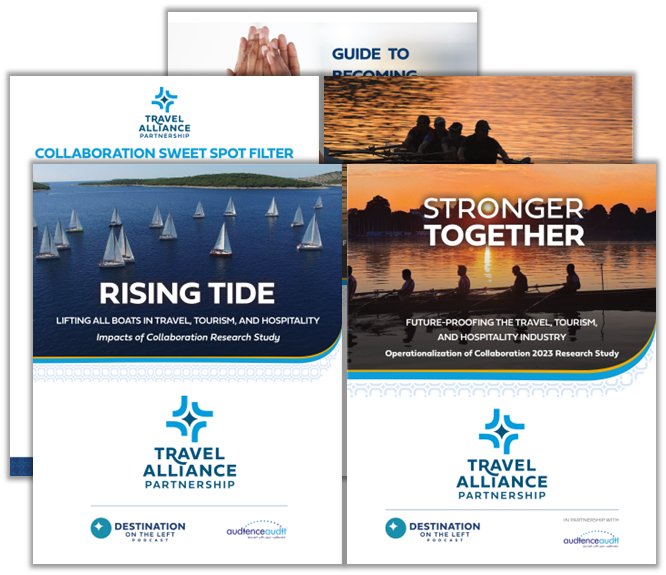Building an Effective Tourism Marketing Team
When it comes to effective marketing, the people on your team and the makeup of the team are a key component of how well everything works. Hiring marketing positions in-house can be a critical step to keep momentum for tourism businesses and organizations. Many of our clients have a dedicated marketing person. If you’re thinking about adding a position to make the most of your marketing efforts, you may be ready for the next level of a tourism marketing team.

Signs you need an in-house marketing position
When and why should you look at adding someone in-house? Let’s look at how to navigate some common marketing challenges through the lens of strategic alignment and clarity of roles. Consider these factors for a sign that your company has grown to a size where an in-house marketing role makes sense.
Spinning Your Wheels
If you feel like you are spinning your wheels with your efforts, stagnating where you thought you’d have growth, this may be a sign that you need to realign with strategy. What strategy can do in this case is re-align everyone. Even if the in-house team doesn’t have a basis in strategy, working with a partner who can make a plan helps the in-house team by providing a road map to work from that keeps everyone moving in the same direction.
Lack of Marketing Leadership
In most cases, our clients have a good understanding of marketing and expectations of marketing activities. However, if leadership doesn’t have a marketing background or their growing business takes their attention away from overseeing marketing activities, that role needs to be filled.
Growing Fast
A growing company often has a lot going on – and to coordinate the marketing of all the right pieces requires both an understanding of the marketing tools AND the business itself! They need an intimate view of what they are marketing. Adding a marketing role in-house will help because this person will learn the ins and outs of the company as they work alongside leadership and sales, talk to partners and customers, etc. They become the bridge between the company or organization and external partners.
Tourism Marketing Team Roles
Having a plan is good, and another layer to effective tourism marketing efforts is having a tourism marketing team in place. Your team needs to be able to create the plan and execute on it. Let’s take a look at the different marketing role possibilities and what each entail so you can discern what level you are looking for.
Chief Marketing Officer (CMO)
A Chief Marketing Officer oversees marketing at the highest level. They are directing strategy and overseeing the execution of tasks. While new ideas can from anywhere on their team, they are not usually executing day-to-day tasks like posting to social media or sending email campaigns. They are more concerned with driving goals forward and coordinating resources to get those tactics taken care of. This is not an exhaustive list by any means, but a good start to think about general skillsets by level.
Marketing Director
A marketing director is well-versed in marketing tactics and can also lead strategically. While they may not be directly in leadership for the company or organization, they have a solid understanding of the goals and how to achieve them with marketing efforts. This role has a little more hand in the day-to-day activities such as writing copy and setting the tone for campaigns but is typically doing more review and approvals than generating tons of content.
Marketing Manager
A tourism marketing manager is adept at handling marketing execution tasks and is gaining strategic chops. They are great at following a plan and understanding how to be flexible with the plan to stay on track with those goals.
Marketing Coordinator
A marketing coordinator is in the thick of it, creating lots of content. They are passionate and creative and enjoy keeping up with all the marketing channels. Without a plan, a coordinator and manager may get lost in the weeds of keeping up with the never-ending content requests or pulled off-track by competing requests or priorities.
What makes marketing strategic?
Start with strategy. That’s how we operate – making sure that all our work is aligned with the overall goals of any company or organization we’re working with on any kind of marketing initiative. The bottom line with anything being strategic is that it is directly tied to goals and is measurable. Measurable meaning that we define what success looks like before starting out on the marketing execution.
Just because you have marketing in place, does not necessarily mean it is strategic. In order for it to be strategic, you need (at the very least):
- Tied to organizational goals. For your current marketing plan, what are the goals? Are they specific to marketing (such as “grow Instagram following by 10%”) or are they organizational (such as “grow our audience by 10%)? Does each marketing channel tie back to those goals? Are the goals SMART or are they vague? If the goals don’t drive to a major initiative, then you have room for stronger goals and more effective marketing.
- Measurable. This is another sign that your marketing is going to effectively drive to your goals. Define what success looks like for each goal, and set up measurement at the start. Establish regular chekpoints for looking at the metrics to make sure you’re on track.
- There is a plan (and you refer to it). A strategy isn’t going anywhere without a detailed plan to follow, and checkpoints to make sure that the tactics outlined in the plan are still moving toward the goals.
Of course, there is much more to a strategic marketing plan than the goals, measurement and checkpoints. Our full strategic marketing plans are built using 7 steps and the final piece has many components, including target audiences and key messages, research and insights, tactical plan and more.
A well-rounded team
No matter how many people are on your in-house team, companies, and organization large and small still supplement with outside resources. These might be agencies, freelancers, or consultants who have expertise in a certain area that assist in filling gaps of knowledge or helping with capacity.
Tools and Technologies
The technologies and tools your team has to work with are as much a part of the team as any coworker or partner. We are continually vetting new technologies and evaluating our “tech stack” to be at our best with our own marketing, and what we recommend to partners. The right tech makes everything more efficient, so make sure you have the right tech in the right “seats.”
Working in or with travel trade? Make sure you have a CRM that fits your business.
Having an agency on your tourism marketing team
Supplementing in-house marketing teams with agency partners is an effective way to add capacity, expertise and success. When our clients decide it’s time to add an in-house role, it enhances the relationship between our team and our clients’ teams and leads to greater strategic results, along wtih key factors that contribute to achieving it.
Collaboration and communication
A successful relationship with external partners hinges on collaboration and communication (and the other 3C’s of Collaboration fit, too). Just like any working relationship, it needs clear objectives, communication protocols, open dialogue and adaptability.
Keep reading:
- How to choose a marketing agency
- 5 Questions to ask your next marketing agency
- How to work with an agency
Are you ready to expand your in-house team?
If you’re thinking about adding a marketing role to your internal team , take a look at the signs that are pointing you in that direction. Consider what type of role you’d be adding, and how you would make sure they have the structure, resources and tools they need to be successful.
Author
Related Posts
Driving Visitation Through Culinary Tourism
When visitors come to a destination, they’re looking for experiences that feel authentic and unforgettable. Few things connect people—or capture the essence of a place—like…
Creating a Strategic Travel and Tourism Marketing Plan: A Step-by-Step Guide
Strategic marketing is about attracting the right people, at the right time, with the right message. A clear, strategic marketing plan is your blueprint for…
